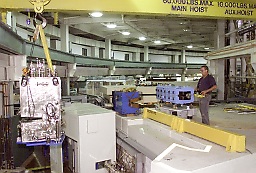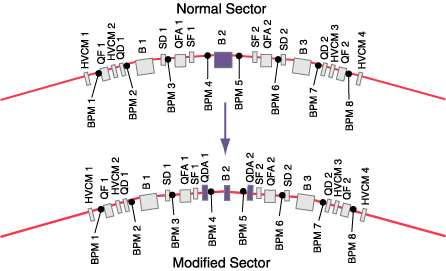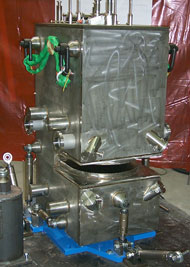
Superbends at the ALS: A Perfect Fit
One by one, the pieces fell into place. Slowly but surely, the story lines converged. The development of superconducting bend magnets ("superbends"), intended to expand the capabilities of the ALS in general, dovetailed neatly with the extraordinary growth of protein crystallography research in recent years. The superbends will allow up to 12 new beamlines of intermediate energy (from 7 to 40 keV) without sacrificing the quality or quantity of light available at the lower energies. This will be more than enough to accommodate the fast-growing protein crystallography community and to provide complementary diffraction, spectroscopy, and imaging capability for materials science in the higher energy range. Superbends, in other words, are tailor-made for the future of the ALS. When the superbend-enhanced ALS starts up for user operations this week, it will mark the beginning of a new era in its history. It will be a testament to the vision, ingenuity, and dedication of the multitude of people who contributed over the course of many years to this resounding success story.
|

The first discussions on incorporating superbends into the ALS took place in 1993, between Alan Jackson, who was the ALS Accelerator Physics Group Leader at the time, and Werner Joho, who was here on sabbatical from the Paul Scherrer Institute in Switzerland. The ALS, somewhat constrained by its available acreage, was originally designed to be a 1- to 2-GeV third-generation light source, whose straight sections were optimized to serve the vacuum-ultraviolet (VUV) and soft x-ray (SXR) communities. Since then, however, light sources have been trending upwards in energy. One way for the ALS to follow this trend would have been to use some of its scarce straight sections for higher-energy wiggler insertion devices. A less costly alternative, proposed by Jackson and Joho, was to replace the ALS's normal dipole bend magnets with superconducting dipoles that could generate higher magnetic fields within the available space.
|
What's the Big Deal?
|
||||
In 1993, newly hired accelerator physicist David Robin was assigned the task of performing preliminary modeling studies to see how superbends could fit into the storage ring's magnetic lattice and to determine whether the lattice symmetry would be broken as a result. He concluded that three 5-Tesla superbends (compared to the 1.3-Tesla normal bend magnets), deflecting the electron beam through 10 degrees each, could indeed be successfully incorporated into the storage ring. 
Then, beginning in 1995, Clyde Taylor led a Laboratory Directed Research and Development (LDRD) project to design and build a superbend prototype. By 1998, the collaboration (which included the ALS Accelerator Physics Group, the Superconducting Magnet Program of Berkeley Lab's Accelerator and Fusion Research Division, and Wang NMR, Inc.) produced a robust magnet that reached the design current and field without quenching (i.e., loss of superconductivity). The basic design, which has remained unchanged through the production phase, includes a C-shaped iron yoke with two oval-shaped poles protruding into the gap. The superconducting material consists of wire made of niobium-titanium alloy in a copper matrix, over a mile long, wound over 2000 times around each pole. The operating temperature is about 4 K.
|
|||||
More ALS Science

